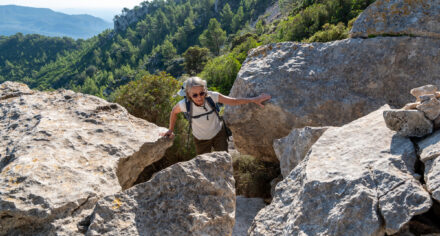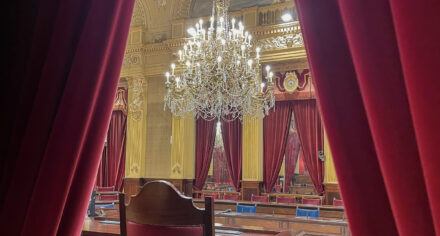You almost don’t notice it. Castell de Santueri lies camouflaged atop its limestone ridge. A crumbling silhouette that emerges only as you near, the very definition of a hidden rock castle. The ruins hang in an uncanny stillness, the air tinged with echoes of centuries past, immersive and hushed. From the plateau you gaze over rolling fields, the distant sea, and the sun-washed hills. And suddenly history blooms before your eyes. A perfect setting for hikers or cyclists eager for both challenge and wonder.
Wandering the Ruins
The Castell crowns the 423 m-high Puig de Santueri, one of only three cliff‑top rock castles on Mallorca. Its white‑lime walls and towers cling to the steep plateau, as if grown from the rock itself. Wander among the fragmentary battlements, arrow slits, and the Tower of Homage. Each whispering stories of defense and refuge.

Inside, the layout hints at former self‑sufficiency. There was once a chapel, mills, bakery, cisterns, stables, and even a hydraulic network for long sieges. From here, your eyes drift to the north, where the Santuari de Sant Salvador stands atop its own ridge, an ever‑present companion in the panorama.
Rock Castles of Mallorca
Castell de Santueri shares its dramatic idea with Castell del Rei and Castell d’Alaró, other Mallorca fortresses perched in near‑inaccessible terrain. Like the others, Santueri’s design exploits natural geology to repel invaders.

Castell del Rei, for example, remains nearly hidden in the Vall de Ternelles near Pollença. Shrouded within a protected sanctuary of monk vultures. Only guided visits are allowed, making it an exclusive insight into history and nature in one. Santueri may be more open, but the sense of ancient fortitude and solitude binds them as kindred guardians of the island.

Centuries on the Edge
The history of Castell de Santueri is as jagged and layered as the rock it sits on. Originally built atop a Roman watchtower, the site was later fortified by the Moors before being taken during the Christian reconquest of Mallorca in the 13th century. King Jaume I seized the castle in 1229, and it was soon rebuilt and strengthened to guard the island’s vulnerable southeast.

Throughout the late Middle Ages, Santueri played a strategic role protecting the important harbour of Portocolom. It remained active until the 19th century, long after its military significance had faded. Today, the ruins speak quietly of those turbulent centuries, and the enduring human impulse to build where no one dares climb.
Routes to Santueri
Reaching Castell de Santueri is part of the experience. From Felanitx, a serpentining road leads to a small parking area, from which a few minutes’ walk brings you to the ruins. Alternatively, you may set out from s’Horta or Es Carritxo.

For a rewarding extension, follow the hairpin‑turn route from around the second‑to‑last bend and hike onward to the Santuari de Sant Salvador. The path is steep but generous with views. Once at the top, the panorama from inland hills to distant sea is nothing short of magnificent.

Easy to Miss but Impossible to Forget
Castell de Santueri is a fortress that’s easy to miss but impossible to forget. A storybook ruin perched on a rocky mountain top. Its ancient walls and sweeping vistas make for an attractive destination for hikers, cyclists, and history seekers alike. Whether arriving by road or trail, the climb rewards you with silence, sight, and a tangible sense of Mallorca’s layered past.
Summer opening hours are Monday to Friday from 10.30 a.m. to 18 p.m. More information on the website. ![]()
Read more about the castles on Mallorca, right here.
Camí des Castell
07208 Felanitx






